Electric Unmanned Aerial Vehicle Market Size
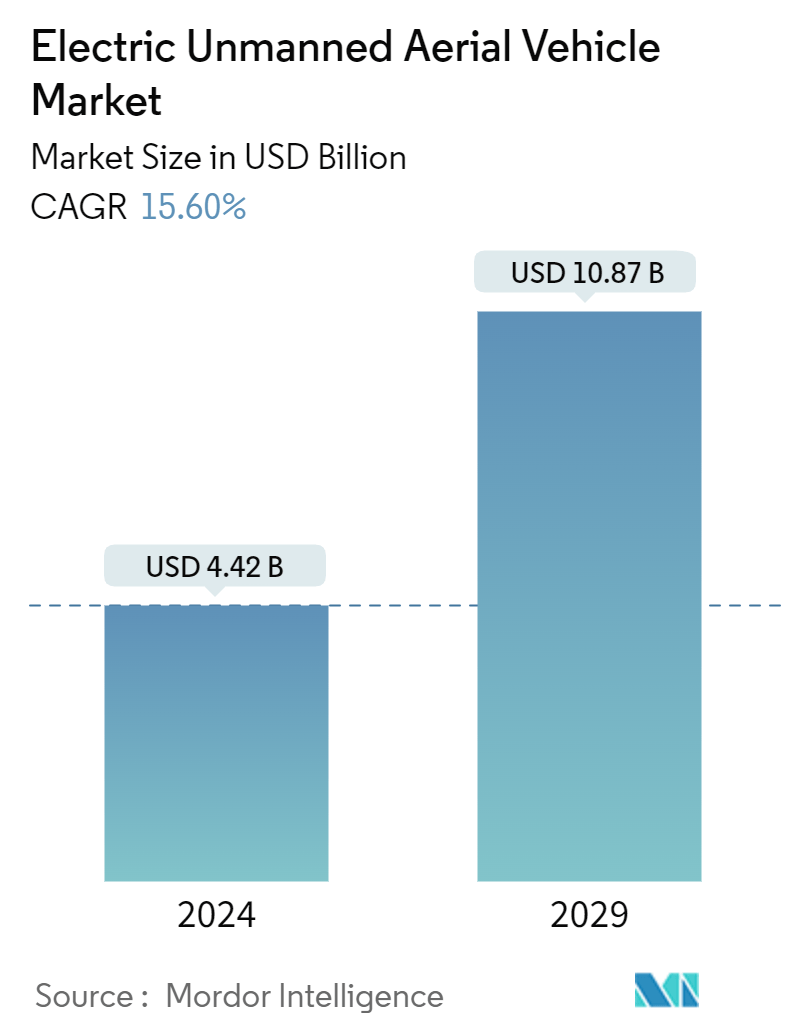
| Study Period | 2019 - 2029 |
| Market Size (2024) | USD 4.42 Billion |
| Market Size (2029) | USD 10.87 Billion |
| CAGR (2024 - 2029) | 15.60 % |
| Fastest Growing Market | North America |
| Largest Market | North America |
Major Players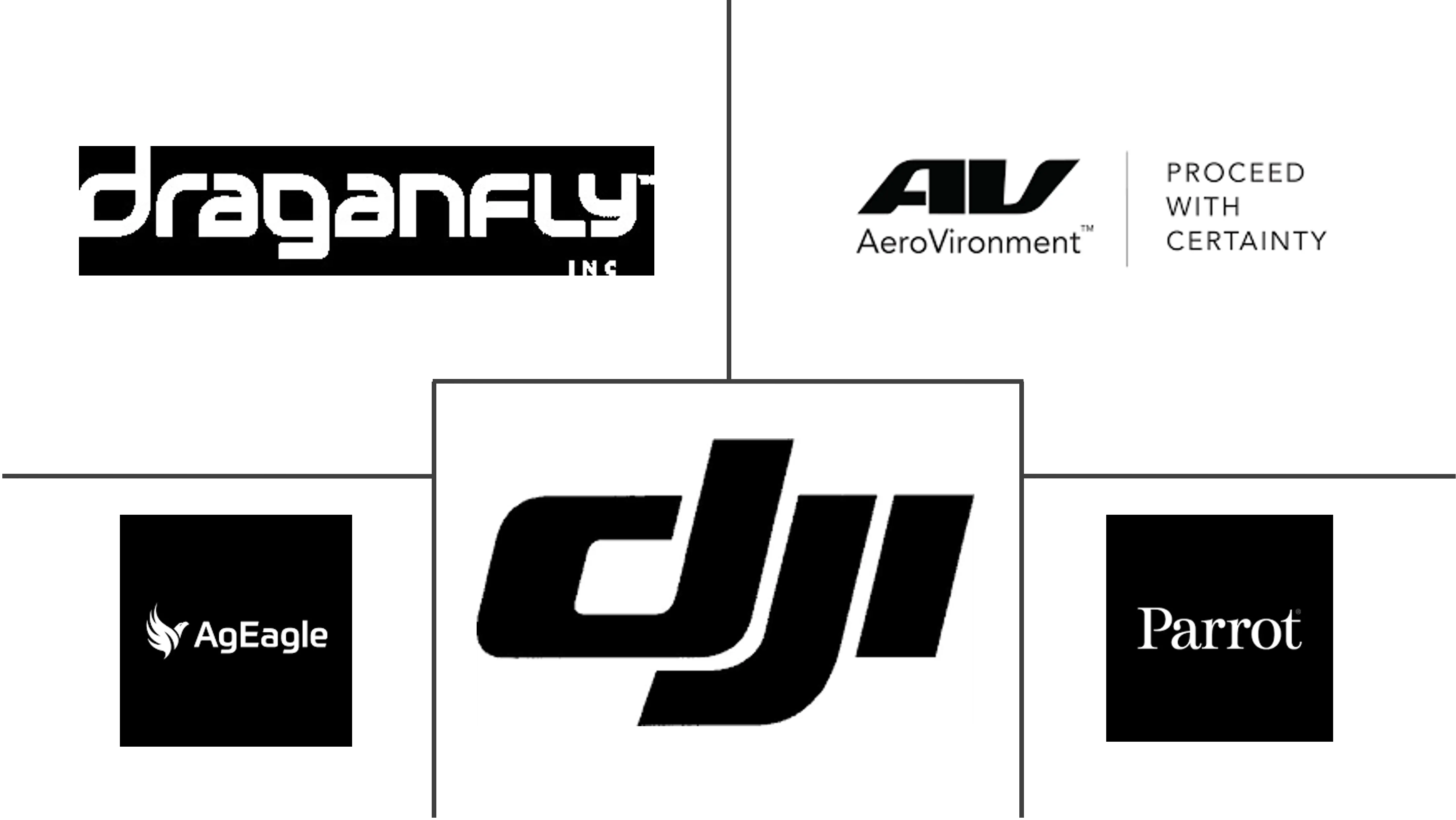
*Disclaimer: Major Players sorted in no particular order |
Electric Unmanned Aerial Vehicle Market Analysis
The Electric Unmanned Aerial Vehicle Market size is estimated at USD 4.42 billion in 2024, and is expected to reach USD 10.87 billion by 2029, growing at a CAGR of 15.60% during the forecast period (2024-2029).
- For several years, the unmanned aerial vehicle (UAV) market has been developing, and it is facing a need for more adoption in the commercial sector. Although initially viewed as military devices, drones have established a significant presence in the commercial sector over the past five years. Over the years, with several new exemptions from governing bodies like the FAA and EASA, the demand for UAVs has emerged from various industries, like infrastructure, agriculture, transport, entertainment, security, and insurance.
- Advancements in UAV flight technologies have allowed manufacturers to produce various models in different sizes, weights, and shapes, carrying different sensor payloads, making them favorable across a broad application base. Moreover, Ongoing efforts to reduce production costs and enhance manufacturing efficiency make electric UAVs more economically viable, attracting a more comprehensive range of consumers.
- One significant restraint is the limited endurance of electric UAVs compared to traditional fuel-powered counterparts. Despite advancements in battery technology, some applications require longer flight durations, posing challenges for electric UAV adoption in specific scenarios. Associated safety concerns with UAVs are anticipated to further restrict the growth of the E-UAV market to a certain extent.
Electric Unmanned Aerial Vehicle Market Trends
Battery Segment to Dominate Market Share During the Forecast Period
- The electric UAV market is dominated by battery technology, owing to its unparalleled reliability and proven track record. Batteries, with their adaptability and versatility, emerge as the preferred power source across diverse UAV applications, from agriculture to infrastructure inspection. The well-established infrastructure supporting battery technology, including charging stations and management systems, further propels its widespread adoption. With growing investment in the drone industry, companies are intensifying R&D, particularly in enhancing battery technologies.
- These investments foster innovations to address critical challenges such as battery life, weight, and efficiency, making battery-powered electric UAVs more viable and competitive. The UAV industry is witnessing advancements in Battery Management Systems (BMS) and energy storage solutions, propelling the adoption of battery-powered drones. This trend aligns with the broader global focus on sustainability, as electric UAVs offer environmentally friendly alternatives to traditional fuel-powered counterparts.
- Similarly, continuous advancements in battery materials and electrochemistry ensure an evolving technology that balances efficiency, weight considerations, and overall performance. In comparison, challenges like intermittent sunlight for solar power and infrastructure limitations for fuel cells hinder their widespread implementation, emphasizing the entrenched position of batteries as the industry standard for powering UAVs. Moreover, the current cost-effectiveness of battery technology compared to solar and fuel cell alternatives contributes to its dominant market share, and batteries have become the industry standard for powering UAVs, leading to a higher level of acceptance and integration across different UAV models and manufacturers.
- For instance, in December 2022, Packet Digital was awarded a USD 8.5 million contract to supply unmanned aircraft systems (UAS) smart batteries, chargers, and power systems for the US Navy. As per the contract, Packet Digital was responsible for designing and manufacturing high-performance UAS battery systems for the next generation of Navy Maritime Logistics UAS.
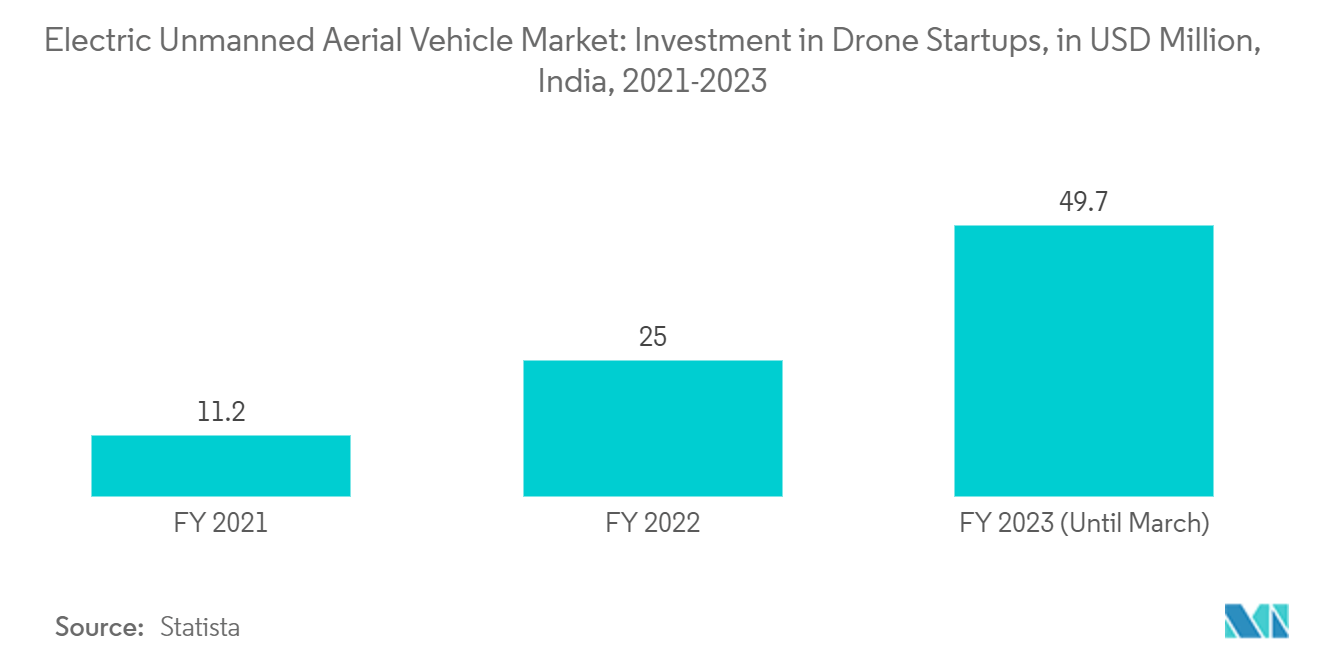
North America to Dominate the Market During the Forecast Period
- The vast expanse of geographic national borders of countries such as the US necessitates the deployment of UAVs to ensure continuous coverage in the regions that are unreachable by patrol forces. The need has resulted in a subsequent increase in demand for E-UAVs with enhanced endurance and lower operational costs to fulfill the operational requirements of the US border patrol forces. Furthermore, the significant deployment of tactical UAVs in military and defense applications has increased the procurement of small UAVs. Since small UAS are powered by some electric power system, the augmented procurement rate would drive the E-UAV market in the region.
- The US military and its partners are widening their scope of drone operations to include logistics missions such as resupply to forces in enemy territories or remote locations. Unique design features are empowering alternative uses for UAVs. The US Department of Defense (DoD) and the National Aeronautics and Space Administration (NASA) are investing heavily in the R&D of advanced engines and associative components for military UAVs, which will replace the existing propulsion systems. The growing demand for UAVs has resulted in several business opportunities in the region, and numerous contracts are being handed out to cater to the broad clientele.
- For instance, in July 2023, under the ANCILLARY program, the US Defense Advanced Research Project Agency’s (DARPA) Tactical Technology Office awarded Northrop Grumman Corporation a contract to develop an autonomous vertical takeoff and landing (VTOL) uncrewed aircraft. The UAV will have electric motors powering ducted fans and a hybrid-electric power source with batteries.
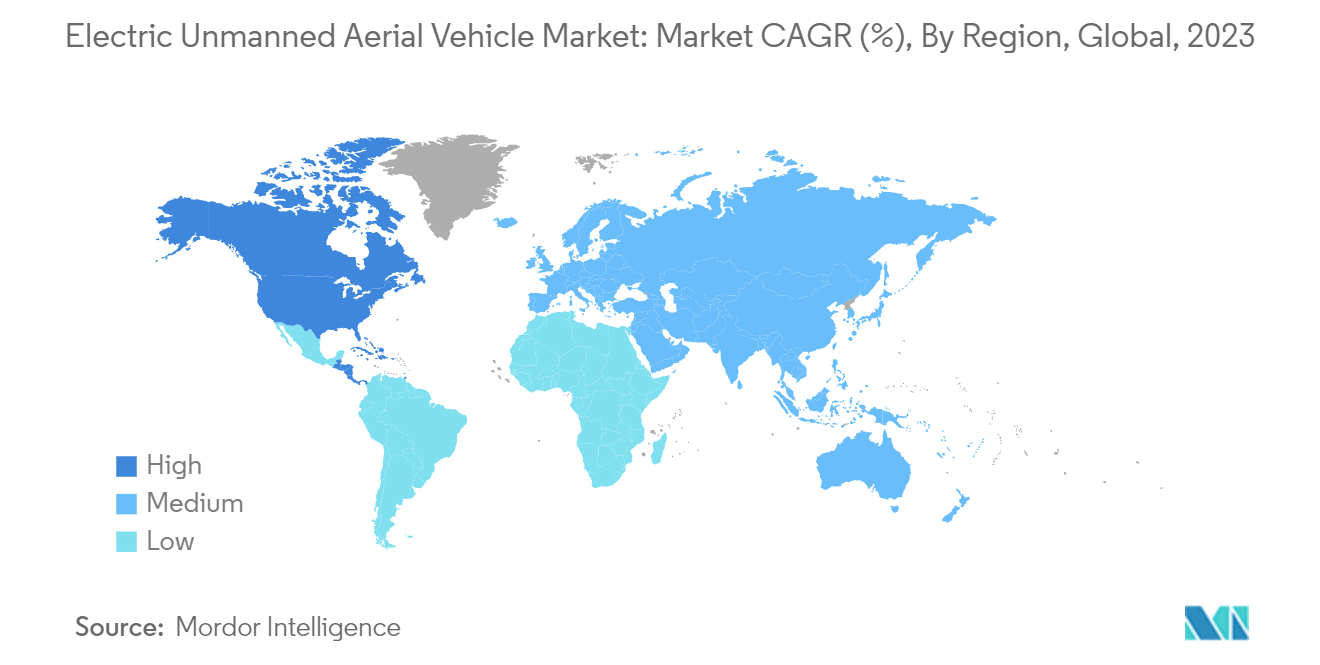
Electric Unmanned Aerial Vehicle Industry Overview
The electric unmanned aerial vehicle market is fragmented and has many active players. Some prominent ones are AeroVironment, Inc., AgEagle Aerial Systems Inc., SZ DJI Technology Co., Ltd., Parrot Drones SAS, and Draganfly Inc. The prevalent economic situations primarily influence the sales of technology-based platforms such as UAVs in dominant markets such as the US and Europe. Hence, in periods of economic downturn, purchases may be subjected to deferral or cancellation and a relatively slower adoption rate, which, in turn, can adversely affect the market dynamics. Product innovation is a primary focus in the E-UAV market, and associative component vendors continuously invest in R&D activities to enhance their product offerings.
The market players intend to devote significant resources and efforts to capitalizing on UAVs' technological proficiency and enhancing their penetration into the rapidly evolving commercial segment of the e-UAV market. Diversification of geographical markets, in tandem with product offerings, would be a key criterion for ensuring profitability and survival in the long run.
In September 2023, Teal Drones signed a USD 1.8 million contract with the US Customs and Border Protection to provide Teal 2 systems to US Border Patrol. Teal drones will deliver 106 Teal 2 drones plus spare parts and training. The US Border Patrol uses the Teal 2 drone to provide situational awareness for US field commanders and agents. Teal Drone has partnered with ESAero for a multi-battery charger, an accessory with the Teal 2 drones. ESAero’s multi-battery charger will enable charging backup batteries while the UAV is in operation to support persistent ISR missions.
Electric Unmanned Aerial Vehicle Market Leaders
-
AeroVironment, Inc.
-
AgEagle Aerial Systems Inc.
-
SZ DJI Technology Co., Ltd.
-
Parrot Drones SAS
-
Draganfly Inc.
*Disclaimer: Major Players sorted in no particular order
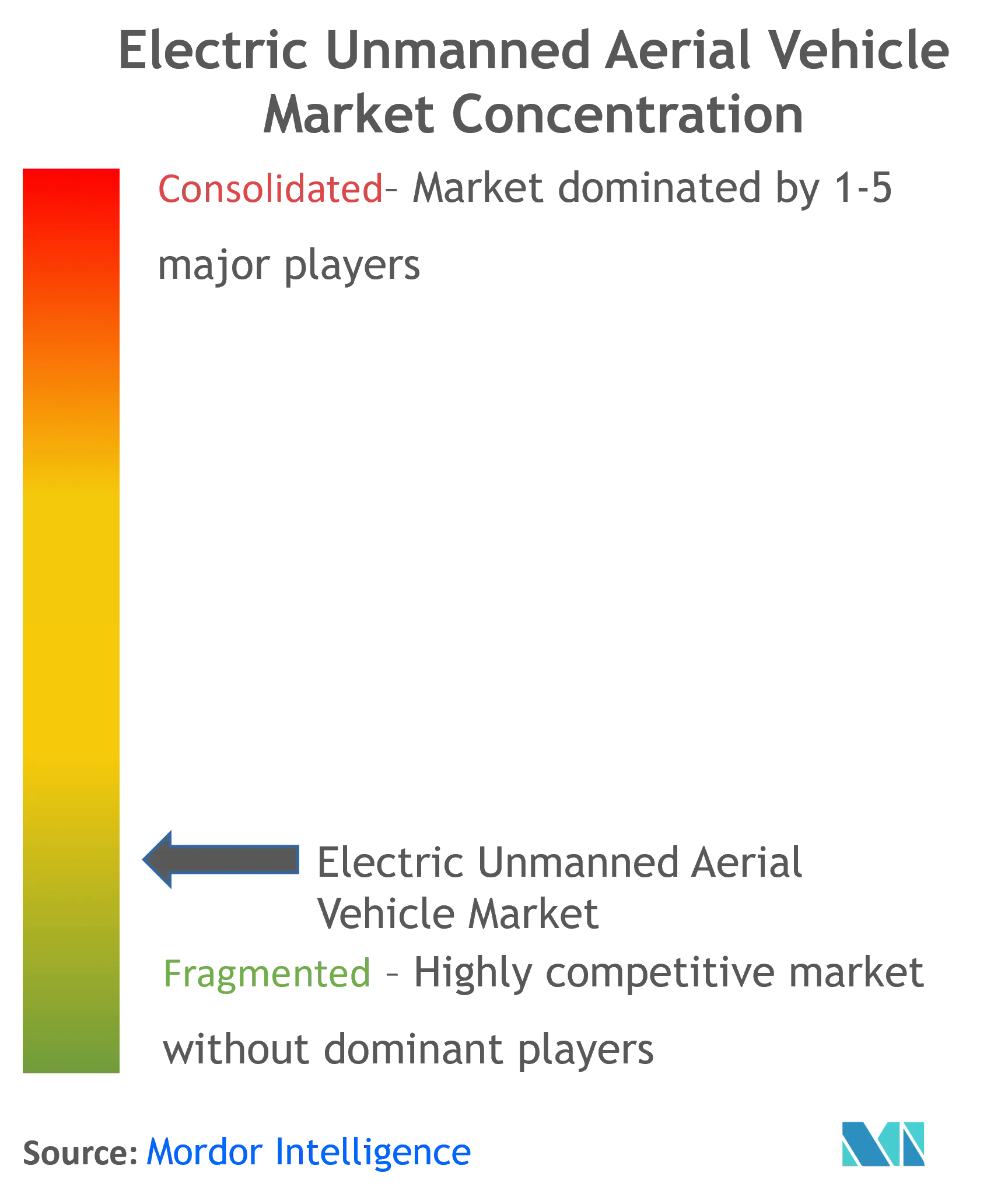
Electric Unmanned Aerial Vehicle Market News
- April 2023: Solar Industries, an Indian UAV startup, secured a contract to supply its indigenous electric unmanned aerial vehicle (UAV) 'Nagastra' to the Indian Army, surpassing competitors from Israel and Poland. The Nagastra UAV delivers GPS-enabled precision strikes with remarkable 2-meter accuracy. With a 60-minute endurance, a 15 km man-in-loop range, and a 30 km autonomous range, it excels in day-night surveillance. Notably, its recoverable parachute mechanism enhances its reuse potential, positioning it as a superior system in the rapidly evolving drone warfare landscape.
- April 2023: Amprius Technologies, Inc. was awarded a contract to supply AeroVironment with commercial-level shipments of Amprius drone batteries for the Switchblade 300 Block 20 loitering missile system, also known as the 'Suicide Drone.' The Amprius lithium-ion battery cells are expected to increase the drone's flight time by at least 50%, enhancing its flight endurance and loitering capability.
Electric Unmanned Aerial Vehicle Market Report - Table of Contents
1. INTRODUCTION
- 1.1 Study Assumptions
- 1.2 Scope of the Study
2. RESEARCH METHODOLOGY
3. EXECUTIVE SUMMARY
4. MARKET DYNAMICS
- 4.1 Market Overview
- 4.2 Market Drivers
- 4.3 Market Restraints
-
4.4 Porter's Five Forces Analysis
- 4.4.1 Bargaining Power of Buyers/Consumers
- 4.4.2 Bargaining Power of Suppliers
- 4.4.3 Threat of New Entrants
- 4.4.4 Threat of Substitute Products
- 4.4.5 Intensity of Competitive Rivalry
5. MARKET SEGMENTATION
-
5.1 Technology
- 5.1.1 Battery
- 5.1.2 Solar
- 5.1.3 Fuel-Cell
-
5.2 Geography
- 5.2.1 North America
- 5.2.1.1 United States
- 5.2.1.2 Canada
- 5.2.2 Europe
- 5.2.2.1 United Kingdom
- 5.2.2.2 France
- 5.2.2.3 Germany
- 5.2.2.4 Russia
- 5.2.2.5 Rest of Europe
- 5.2.3 Asia-Pacific
- 5.2.3.1 China
- 5.2.3.2 India
- 5.2.3.3 Japan
- 5.2.3.4 South Korea
- 5.2.3.5 Australia
- 5.2.3.6 Rest of Asia-Pacific
- 5.2.4 Latin America
- 5.2.4.1 Brazil
- 5.2.4.2 Mexico
- 5.2.4.3 Rest of Latin America
- 5.2.5 Middle-East and Africa
- 5.2.5.1 Saudi Arabia
- 5.2.5.2 United Arab Emirates
- 5.2.5.3 South Africa
- 5.2.5.4 Rest of Middle-East and Africa
6. COMPETITIVE LANDSCAPE
- 6.1 Vendor Market Share
-
6.2 Company Profiles
- 6.2.1 Aeronautics Ltd.
- 6.2.2 AeroVironment, Inc.
- 6.2.3 AgEagle Aerial Systems Inc.
- 6.2.4 Parrot Drones SAS
- 6.2.5 Draganfly Inc.
- 6.2.6 SZ DJI Technology Co., Ltd.
- 6.2.7 Bye Aerospace
- 6.2.8 Elbit Systems Ltd.
- 6.2.9 Teledyne FLIR LLC
- 6.2.10 VAYU Aerospace
- 6.2.11 Airbus SE
- 6.2.12 Intel Corporation
- 6.2.13 Lockheed Martin Corporation
- 6.2.14 RTX Corporation
- 6.2.15 Sunlight Aerospace
- *List Not Exhaustive
7. MARKET OPPORTUNITIES AND FUTURE TRENDS
** Subject To AvailablityElectric Unmanned Aerial Vehicle Industry Segmentation
An electric unmanned aerial vehicle (E-UAV) utilizes the electrical energy stored in charge inside a battery or fuel-cell stack to drive the direct current (DC) brushless motor and generate thrust. The report includes only the revenue generated from the sale of line-fit integration of UAV platforms. It excludes the revenue generated from selling individual spare parts and aftermarket services.
The electric unmanned aerial vehicle market is segmented by technology and geography. By technology, the market is segmented into battery, solar, and fuel-cell. The report also covers the market sizes and forecasts for the electric unmanned aerial vehicle market in major countries across different regions. For each segment, the market size is provided in terms of value (USD).
| Technology | Battery | |
| Solar | ||
| Fuel-Cell | ||
| Geography | North America | United States |
| Canada | ||
| Geography | Europe | United Kingdom |
| France | ||
| Germany | ||
| Russia | ||
| Rest of Europe | ||
| Geography | Asia-Pacific | China |
| India | ||
| Japan | ||
| South Korea | ||
| Australia | ||
| Rest of Asia-Pacific | ||
| Geography | Latin America | Brazil |
| Mexico | ||
| Rest of Latin America | ||
| Geography | Middle-East and Africa | Saudi Arabia |
| United Arab Emirates | ||
| South Africa | ||
| Rest of Middle-East and Africa |
Electric Unmanned Aerial Vehicle Market Research FAQs
How big is the Electric Unmanned Aerial Vehicle Market?
The Electric Unmanned Aerial Vehicle Market size is expected to reach USD 4.42 billion in 2024 and grow at a CAGR of 15.60% to reach USD 10.87 billion by 2029.
What is the current Electric Unmanned Aerial Vehicle Market size?
In 2024, the Electric Unmanned Aerial Vehicle Market size is expected to reach USD 4.42 billion.
Who are the key players in Electric Unmanned Aerial Vehicle Market?
AeroVironment, Inc., AgEagle Aerial Systems Inc., SZ DJI Technology Co., Ltd., Parrot Drones SAS and Draganfly Inc. are the major companies operating in the Electric Unmanned Aerial Vehicle Market.
Which is the fastest growing region in Electric Unmanned Aerial Vehicle Market?
North America is estimated to grow at the highest CAGR over the forecast period (2024-2029).
Which region has the biggest share in Electric Unmanned Aerial Vehicle Market?
In 2024, the North America accounts for the largest market share in Electric Unmanned Aerial Vehicle Market.
What years does this Electric Unmanned Aerial Vehicle Market cover, and what was the market size in 2023?
In 2023, the Electric Unmanned Aerial Vehicle Market size was estimated at USD 3.73 billion. The report covers the Electric Unmanned Aerial Vehicle Market historical market size for years: 2019, 2020, 2021, 2022 and 2023. The report also forecasts the Electric Unmanned Aerial Vehicle Market size for years: 2024, 2025, 2026, 2027, 2028 and 2029.
Electric Drone Industry Report
Statistics for the 2023 Electric Drone market share, size and revenue growth rate, created by Mordor Intelligence™ Industry Reports. Electric Drone analysis includes a market forecast outlook to 2029 and historical overview. Get a sample of this industry analysis as a free report PDF download.



